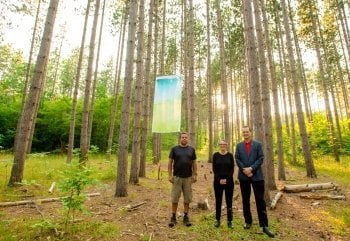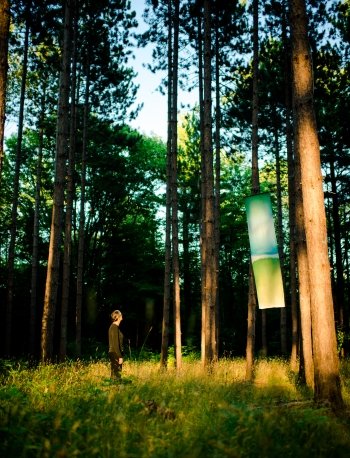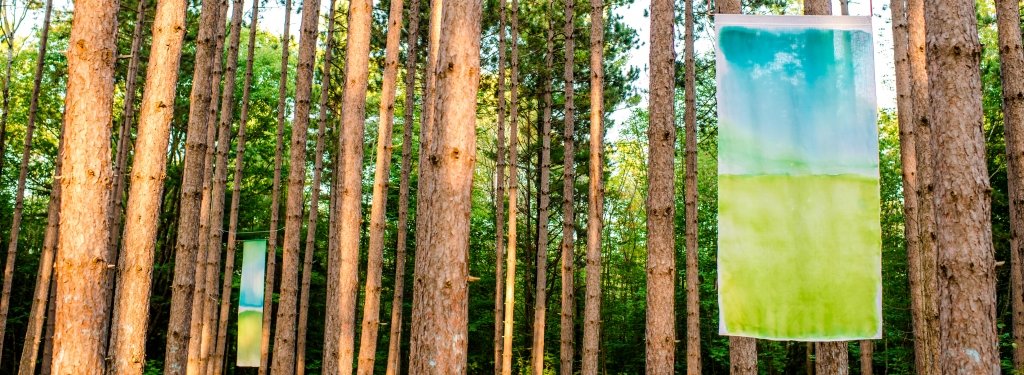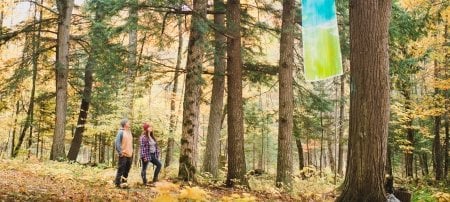Meditation Circuit combines mindfulness meditation and public art in an urban forest.
Imagine the sunlight slanting toward the forest floor, filtered through viridescent leaves and pine needles. Imagine walking slowly, meditatively, through the wedges of light, fully focused on the moment, completely present. Dust motes swirl in the light. Birds call to each other above. A fly buzzes by. Twigs and decaying leaves crunch under foot. From branches above, delicate hemp banners painted in many shades of green to mimic the landscape waft gently on the breeze.
Meditation, the practice of focusing solely on the present moment and letting go of the clutter of the mind, appears to have an increasing number of health benefits. Anne Beffel, professor of visual and performing arts at Michigan Technological University and director of Studio Here Now, intentionally looks for ways to create space for mindfulness within public art. Studio Here Now is a creative public art design studio and gallery located on campus in Wadsworth Residence Hall.
"Art is healing, and that's what I do."
Though she has worked on a number of installations over the years, including “Apologies at the World Financial Center,” “Color of Kindness” and “If… Then…” that include aspects of health and healing, Beffel completed mindfulness facilitation at the UCLA Semel Institute for Neuroscience and Human Behavior in 2016.
Beffel will lead a guided walk with City Meditation Crew August 11, 2018 at Hamlin Park in Shoreline, Washington. City Meditation Crew, a performance art collective, has inspired pedestrians to explore innovative mindfulness practices in public spaces since 2009 in cities from New York to Seattle.
Art as Meditation, Meditation as Art
The Meditation Circuit builds on a public art project in Shoreline in 2017 titled “Many Shades of Green,” created for David Francis, public art coordinator for the Department of Parks, Recreation and Cultural Services in Shoreline, and is presented with the Shoreline Walks program volunteers including Alice Lawson and staff member Marianne Johnson.

During the "Many Shades of Green" guided meditation session, participants used cell phones to capture photos of the many shades of green found in the urban forest. The purpose of the cell phone photography was not to take world-class photos, but rather to mindfully meditate on their surroundings through photography. Beffel drew upon participants’ resulting photos as inspiration to create hemp banners painted with the shades of green captured.
Beffel chose hemp summercloth after a lengthy process of testing fabrics in the wind and rain for a balance of airflow and weight. Each step of curating the project was a practice of being sensitive to the materials, the environment into which the banners would be placed and thoughts about who spends time in the park.
“Meditation Circuit is a series of meditation stations along a pathway marked by public art work,” Beffel says. “Each station offers a mindfulness-oriented activity intended to support well-being. Meditation Circuits demonstrate the power of meditation and the value of public art.”
Participants are encouraged to listen to the sounds of the urban forest around them, to stand or walk beneath the canopy of trees, and even to use cell phones as tools of meditation—an idea that runs counter to the concept that cell phones are the ultimate tools of distraction.
Beffel says that the meditation circuit combines the practice of mindfulness with exercise and the enjoyment of the outdoors.
"Art like this in a green space, coupled with meditation and movement is a wonderful idea," says John Durocher, assistant professor of biological sciences who is conducting a National Institutes of Health-funded mindfulness meditation study focused on neural cardiovascular control beginning this autumn. "For those who love the outdoors, I could see it as an attractive option for mindfulness meditation versus sitting in a quiet room.”
Beffel herself began to integrate walking and spending time outdoors into her art during graduate school, when she realized she wasn’t spending time outside or exercising. She says her work is at the intersection of mindfulness, creativity and the outdoors.
“The action of meditation appears simple, but sometimes there’s a lot going on under the surface,” she says. “Meditation requires practice, just like most activities that put us into a state of relaxed concentration, or allow us to be present each moment. Sports, music performance or even painting—all support well-being.”

The practice of meditation is erroneously thought to be “successful” when a person clears or stills the mind and body.
“The practice is actually that of noticing how habitually active our minds and bodies are, and then making the choice to return our attention to one thing—whatever we have chosen as our object of attention or awareness,” Beffel says. “It might be a tree, our foot on the ground, our breath. The acts of noticing and then placing again our mind upon what we choose are the acts of meditation. It is a process not a product.”
The display in Shoreline is not the final stage of the project. A separate set of banners will be displayed by the School of Forest Resources and Environmental Science (SFRES).
“We are increasingly aware of the health benefits of forests and other natural areas, and the interface between natural areas, aesthetics and human well-being is an important area in which we hope to develop deeper understanding,” says Andrew Storer, SFRES dean. “In addition to the banners at the meditation stations, a separate set will be available to the School for display in our atrium and also at the Ford Center and Forest, which presents an opportunity for our students, faculty, staff and alumni to explore the aesthetic side of natural resources through Anne's expertise as a faculty member in visual and performing arts.”
Michigan Technological University is an R1 public research university founded in 1885 in Houghton, and is home to nearly 7,500 students from more than 60 countries around the world. Consistently ranked among the best universities in the country for return on investment, Michigan's flagship technological university offers more than 185 undergraduate and graduate degree programs in science and technology, engineering, computing, forestry, business, health professions, humanities, mathematics, social sciences, and the arts. The rural campus is situated just miles from Lake Superior in Michigan's Upper Peninsula, offering year-round opportunities for outdoor adventure.






Comments